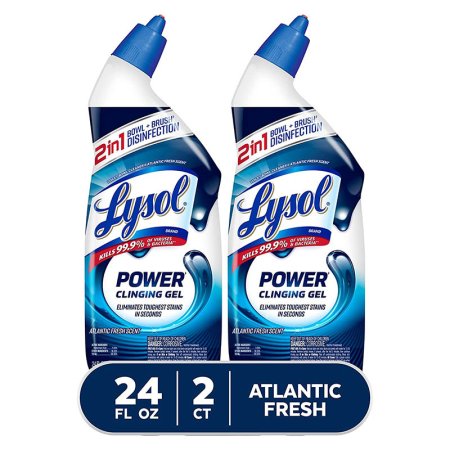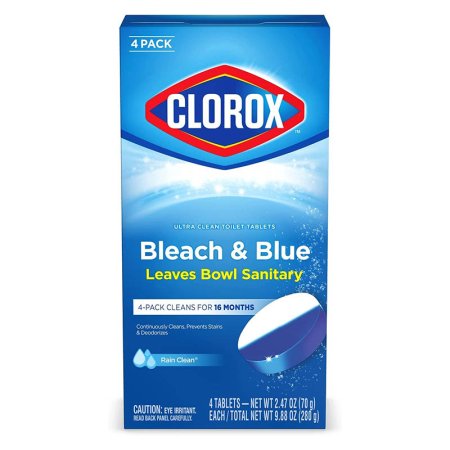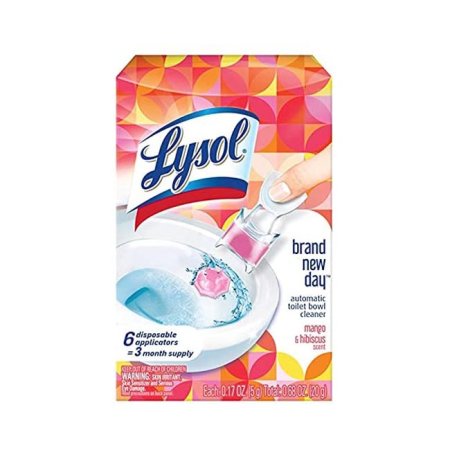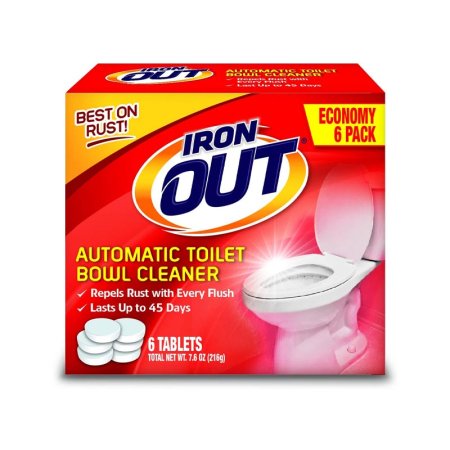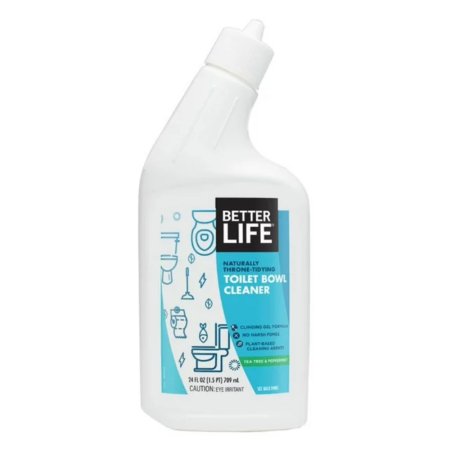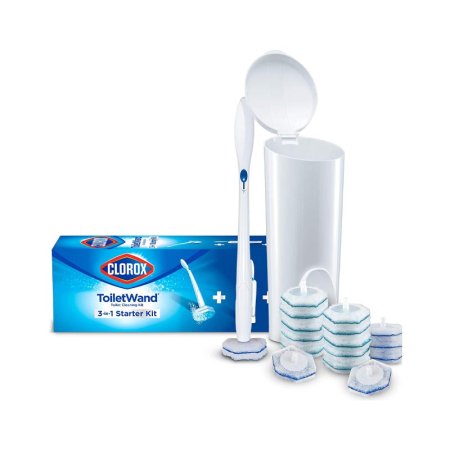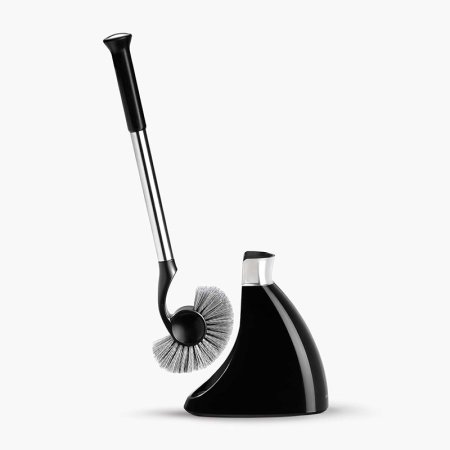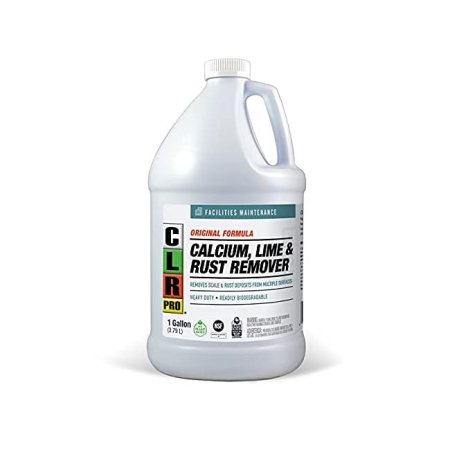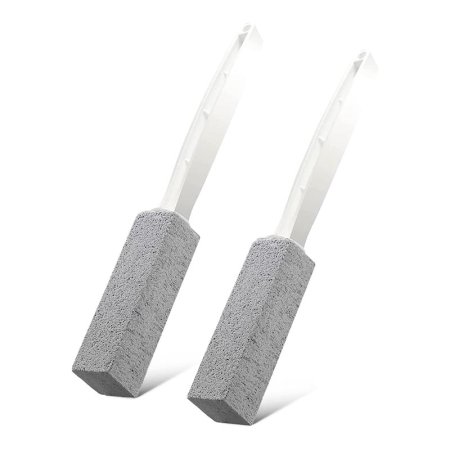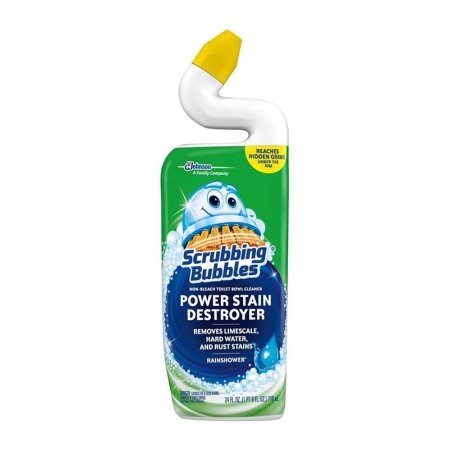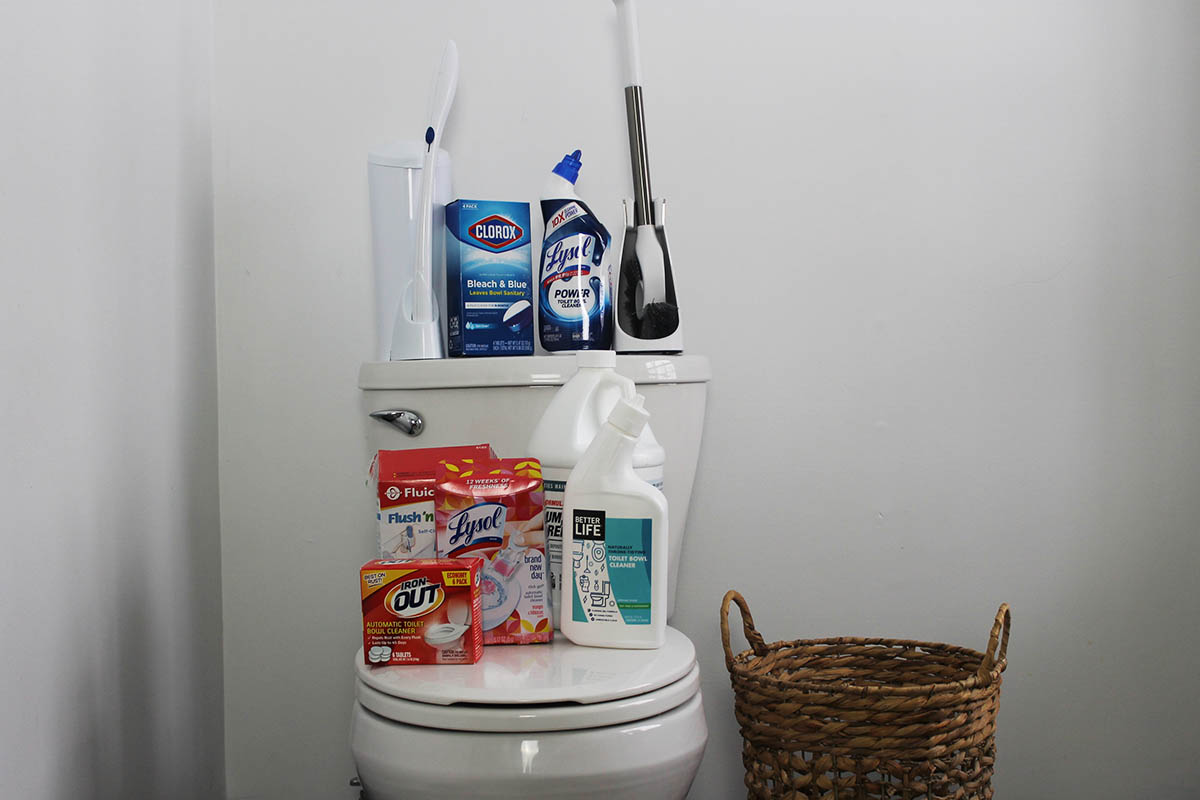
We may earn revenue from the products available on this page and participate in affiliate programs. Learn More ›
Upholding basic sanitary practices to ensure the health of your home calls for regular toilet bowl cleaning. While there are many great products available, the overwhelming number of choices can make it a challenge to choose the right product—so we tested the best toilet bowl cleaners and ranked them by category.
If you don’t want to rely on a household remedy or DIY cleaner, read on to learn how we tested each toilet bowl cleaner and which formulas made the cut.
- BEST OVERALL: Lysol Power Toilet Bowl Cleaner
- BEST BANG FOR THE BUCK: Clorox Automatic Bleach & Blue Toilet Bowl Cleaner
- BEST SCENT: Lysol Click Gel Automatic Toilet Bowl Cleaner
- BEST TABLETS: Iron Out Automatic Toilet Bowl Cleaner
- BEST NATURAL: Better Life Natural Toilet Bowl Cleaner
- BEST CLEANING SYSTEM: Clorox ToiletWand Disposable Toilet Cleaning Kit
- BEST BRUSH: Simplehuman Toilet Brush With Caddy
- BEST FOR STAINS: CLR Pro Calcium, Lime, and Rust Remover
- BEST FOR TOILET RINGS: Kadden Pumice Stone Toilet Cleaner
- BEST FOR LIMESCALE: Scrubbing Bubbles Power Stain Destroyer
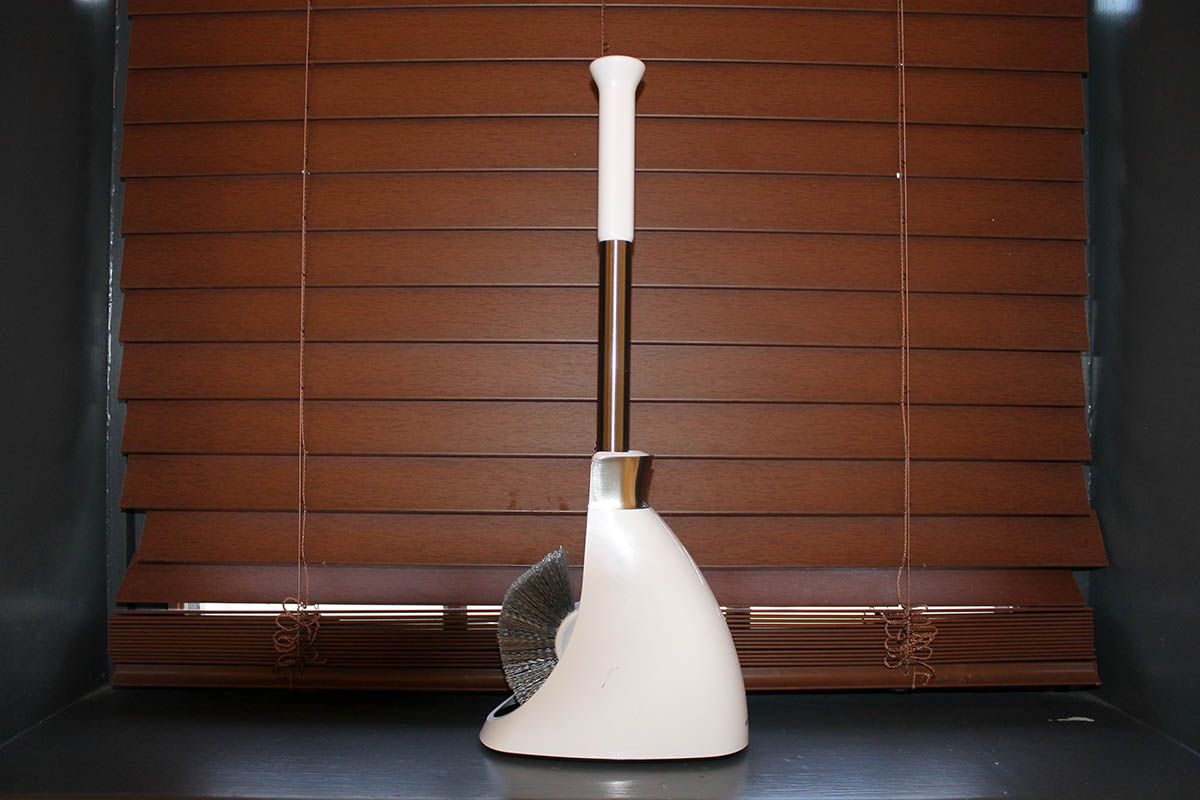
How We Tested the Best Toilet Bowl Cleaners
We spoke to Katelyn Harms, MPH, CIC, a Communications Committee member for the Association for Professionals in Infection Control and Epidemiology (APIC), about why it’s important to keep toilet bowls clean and germ-free. She explained that human waste contains bacteria and viruses. “Flushing a toilet can cause splashes or a plume of droplet aerosols that can contaminate other surfaces in the bathroom.” She went on to say that “salmonella, hepatitis A, and norovirus are all examples of diseases that are commonly associated with bathrooms.” Harms, who also serves as the Infection Prevention program manager for UnityPoint Health-Meriter Hospital in Madison, Wisconsin, pointed out that it’s important to clean the toilet bowl “whenever there is evidence of staining or visible soiling.”
That’s where the best toilet bowl cleaners come in. We researched a variety of products to create our list of best picks. To test single-use toilet bowl cleaners, like gels, toilet bowl brushes, and wands, we allowed our toilets to build up film for 1 week. We then used each product and rated it on how well it cleaned normal buildup and stains. We repeated this process at least twice for all single-use cleaners.
We tested continuous toilet bowl cleaners per the manufacturers’ instructions, using each for at least 7 days. We tested the products (including tablets, cleaning cartridges, and gel stamps) on three different toilets, using each where best intended. Then we evaluated how well each product prevented buildup and how easy it was to use.
We scored the products on a rubric, noting how well each product cleaned the interior of a toilet. We also considered scents, active ingredients, and ease of use. Our list provides options that tackle limescale, toilet rings, rust, stains, hard-water deposits, and calcium.
Our Top Picks
Choosing the right toilet cleaner depends on the type of water in your home, the form you prefer, and how much time you can devote to cleaning. We tested products for each of these categories; here are our top picks.
Best Overall
Lysol Power Toilet Bowl Cleaner
Pros
- The cling gel stays in place, allowing users to spot-treat problem areas
- Powerful formula breaks down stubborn toilet bowl rings and tough stains
- Sanitizes and disinfects toilet bowls, killing up to 99.9 percent of bacteria and viruses
Cons
- Can’t be used with bleach or bleach-containing cleaners
- The scent is not identified, but it does have a minty smell
Product Specs
- Type: Gel
- Chemical or natural: Chemical
- Scent: Yes
With its potent cling gel, Lysol Power toilet bowl cleaner breaks down stains and toilet bowl rings, killing 99.9 percent of viruses and bacteria without the need for scrubbing. Simply use the angled bottle to squirt under the toilet rim, coating the toilet bowl above and below the water line. Then scrub with a toilet bowl brush before flushing.
For disinfecting, let the cleaner sit for 10 minutes, and for stain removal, coat the problem areas and allow the cling gel to work for 15 minutes. While this gel cleaner is septic-system safe, it can’t be combined with chlorine bleach.
We tested this product on a toilet in a kids’ bathroom. The toilet had a ring from a combination of hard-water buildup and not being flushed enough. During testing, we coated the toilet bowl with the product, waited a couple of minutes, and then cleaned it with a toilet bowl brush. The ring disappeared with only a light scrub, exceeding our expectations.
While this product doesn’t list a scent on its packaging, it has a light, minty smell. It’s easy to use, quickly breaking down weekly buildup and set-in stains. It also works as a disinfectant, making it a great addition to weekly bathroom cleaning.
Get the Lysol Power toilet bowl cleaner (2-pack) at Amazon, The Home Depot, or Target.
Best Bang for the Buck
Clorox Automatic Bleach & Blue Toilet Bowl Cleaner
Pros
- Can deodorize and sanitize a toilet bowl with each flush
- 1 box of 4 tablets can last up to 4 months
- Significantly cuts down on toilet buildup and staining, making cleaning easier
- Easy to see when they need replacing as the water becomes less blue
Cons
- Not suitable for toilets that don’t get flushed at least once per day
Product Specs
- Type: Tablet
- Chemical or natural: Chemical
- Scent: Yes
The Clorox name is virtually synonymous with bleach, so it’s no surprise that the company’s affordable toilet tablets rely on bleach as an effective disinfectant and whitening agent. The automatic-action tablets are dropped into the toilet’s tank, where they slowly dispense the product with each flush to continuously clean, prevent stubborn stains, and deodorize.
Each Clorox toilet tablet lasts for 4 months. The product comes in a four-pack, and the packaging claims that these tables have a “fresh” scent.
We tested the Clorox toilet cleaner, and despite bleach being a primary ingredient, the smell wasn’t noticeable. Adding the tablets to the tank was very easy, and they reduced the typical weekly buildup. After the tablet had been in the toilet for a week, a quick swipe with a toilet brush got the bowl perfectly clean.
Since these tablets turn the toilet water a vibrant blue, minor blue streaking may appear if the toilet is not flushed at least once a day. Bleach can also accumulate if the toilet isn’t flushed once a day. However, we felt these were a good automatic toilet bowl cleaner overall and well worth the price.
Get the Clorox automatic toilet bowl cleaner at Amazon, Lowe’s, or Target.
Best Scent
Lysol Click Gel Automatic Toilet Bowl Cleaner
Pros
- Reduces weekly buildup and sanitizes without bleach
- Gel stamps have a strong but pleasant mango-hibiscus smell
- Sanitary application allows users to apply the gel stamps without touching the toilet bowl
Cons
- Requires frequent replacement in busy bathrooms
- The pleasant smell starts to fade after the first day of use
Product Specs
- Type: Gel stamp
- Chemical or natural: Chemical
- Scent: Yes
Simply affix the applicator inside the bowl and the Lysol Click Gel automatic toilet bowl cleaner dispenses continuous refreshing action for up to 2 weeks. Lysol claims this bleach-free product kills 99.9 percent of odor causing bacteria.
The Environmental Working Group (EWG) gives it a B grade for health and environmental factors, noting such concerns as artificial fragrance and the presence of sodium laureth sulfate, which poses certain health and safety risks if overused. However, the results speak for themselves. This easy-to-use toilet bowl cleaner does its job effectively, and its effects are long lasting.
For users looking for a scented toilet bowl cleaner, this one smells pleasant right out of the box. The downside is that after the first day, the smell starts to dissipate. During testing, we found the stamp applicator was easy to use and sanitary for applying the gel stamp—all that was needed was for us to push it onto the side of the toilet bowl and pull it away.
Each box comes with six gel stamps. While the packaging states that each stamp can last up to 2 weeks, we used this in a main bathroom, and about two-thirds of it was gone after the first week. While it didn’t fully eliminate normal buildup, it did a good job of reducing it.
Get the Lysol Click Gel toilet bowl cleaner at Amazon.
Best Tablets
Iron Out Automatic Toilet Bowl Cleaner
Pros
- Easy-to-install tablets remove rust, mold, and hard-water stains
- A single tablet works for up to 45 days for long-lasting cleaning power
- Significantly reduces normal weekly toilet buildup
Cons
- Doesn’t have a scent, so it does not mask bathroom smells
- Should not be used with bleach or bleach-containing toilet bowl cleaners
Product Specs
- Type: Tablet
- Chemical or natural: Chemical
- Scent: No
With six tablets included per pack, this Iron Out automatic toilet bowl cleaner packs a punch for rust, mold, and hard-water stains. Though powerful, this automatic toilet bowl cleaner protects the internal workings of toilets as well as septic systems.
Simply drop a capsule into a toilet every 45 days and let it do all of the cleaning. This method is also odor-free. The only downside is that this cleaner cannot be used with bleach for added cleaning power.
We tested these toilet bowl tablets in an over-20-year-old toilet with rust stains. We added a tablet to the tank and, after about a week, scrubbed the rust with a toilet bowl brush. To our surprise, much of the existing rust came off. It also did an excellent job of preventing normal buildup.
The Iron Out tablets are a good choice for those who have hard water and deal with mineral deposits or rust stains.
Get the Iron Out toilet bowl cleaner at Amazon or Lowe’s.
Best Natural
Better Life Natural Toilet Bowl Cleaner
Pros
- Doesn’t contain any synthetic chemicals, fragrances, petroleum solvents, or phosphates
- Effective at cleaning weekly buildup and staining
- Has a pleasant scent that makes the bathroom smell fresh
Cons
- The cling gel is clear, making it hard to tell which areas of the toilet are coated
- Not labeled as a disinfectant; may be unsuitable for killing viruses and bacteria
Product Specs
- Type: Gel
- Chemical or natural: Natural
- Scent: Yes
Created by two dads, Better Life eschews synthetic fragrances, bleach, dyes, petroleum solvents, and phosphates. Even the containers are sustainably designed, using solar energy and biodegradable material.
Unlike many brands, Better Life lists its ingredients, which include lactic acid as a dirt buster and tea tree oil for its disinfectant properties. All that’s necessary is to squirt it around the bowl and let it sit for 10 to 15 minutes before using a brush.
We used the Better Life natural toilet bowl cleaner on a toilet with a week’s worth of buildup. We coated under the rim, let the cleaner sit for a couple of minutes, and used a toilet bowl brush to work through the grime. It took minimal effort to get the bowl squeaky clean.
This product has a great scent—noticeable without being overpowering or smelling like chemicals. Although it did a great job at cleaning, its clear formula made it hard to tell which areas of the toilet bowl were coated and which weren’t. Also, the packaging doesn’t state that this cleaner can disinfect, which may be a drawback for some.
Get the Better Life toilet bowl cleaner at Walmart or Better Life.
Best Cleaning System
Clorox ToiletWand Disposable Toilet Cleaning Kit
Pros
- Comes with a wand, 16 disposable scrubbing pads, and a storage caddy
- Infused with a bleach cleaning solution that easily removes weekly buildup
- The scrubbing pads click into and out of place for more hygienic toilet cleaning
Cons
- Does little to remove tough stains
- The pads get very sudsy if dipped below the water line during cleaning
- Not eco-friendly; scrubbing brushes produce waste, and the cost can add up
Product Specs
- Type: Cleaning system
- Chemical or natural: Chemical
- Scent: No
One of the worst aspects of toilet cleaning is dealing with a wet, germ-ridden scrub brush. The Clorox ToiletWand cleaning kit comes to the rescue, eliminating the need to use and store a dirty toilet brush. The system includes a toilet wand, storage caddy, and disposable scrub pads infused with bleach-based cleaners. Each scrub pad refill clicks conveniently onto the wand without the need to touch it.
The hexagon-shaped sponge heads reach under the bowl rim and into the drain for a deep clean, removing rust, calcium, and lime stains as they disinfect with bleach. When the user has finished cleaning, all that’s needed is to dispose of the scrub pad in the trash with a click of a button on the wand. The system comes with 16 scrub pads, and extra pads are sold separately.
During testing, we appreciated the design of the Clorox ToiletWand. Using it was easy and felt the most hygienic of the options we tested. The cleaning pads click right in place, and it’s convenient to toss them in the trash afterward.
While the Clorox ToiletWand did a great job cleaning regular buildup, it did little for stains. Those who want to use this product will want to get rid of toilet bowl rings and staining first. Afterward, this is a suitable product for keeping a toilet clean.
Get the Clorox ToiletWand with 16 refill heads at Amazon or with 6 refill heads at Lowe’s, The Home Depot, or Target.
Best Brush
Simplehuman Toilet Brush With Caddy
Pros
- The stiff bristles can remove stains and thick toilet bowl rings
- Safe for septic systems, as it cleans well without using a liquid or gel cleaner
- The magnetic caddy allows the brush to drip dry and ventilate
- Replacement brush heads can be purchased separately
Cons
- Some users report that this model develops stains over time
Product Specs
- Type: Brush
- Chemical or natural: Natural
- Scent: No
The Simplehuman toilet brush features a slender profile that is open at the back for proper air ventilation. The design also allows users to replace the brush head when necessary—a welcome feature. The use of a brush does not require chemicals to keep a toilet clean, making it harmless for septic systems and the inner workings of toilets.
A great option for small bathrooms, this toilet brush features stiff bristles to get stubborn stains out of the entire toilet bowl and has a magnetic strip around the collar of the caddy to ensure the toilet brush stays secure when carried. One con to this design is that the brush might not reach the main drain hole at the bottom of the toilet bowl.
We used the Simplehuman toilet brush several times, cleaning regular sludge, set-in stains, and toilet rings. Its stiff bristles break away grime without the use of an accompanying cleaner. Paired with a toilet bowl cleaner, the cleaning process is even easier.
While we loved the cleaning power, another standout feature is the design. Rather than the brush sitting in stagnant water like most others, it sits above the bottom of the holder so it can drip dry. This brush is a great buy for anyone needing to remove toilet stains or thick toilet bowl rings.
Get the Simplehuman toilet bowl cleaner at Amazon, Wayfair, or Target.
Best for Stains
CLR Pro Calcium, Lime, and Rust Remover
Pros
- Removes stains, calcium, hard-water deposits, lime, soap scum, and more
- Can be diluted for lighter cleaning needs
- Approved by the Environmental Protection Agency’s (EPA) Safer Choice Program
Cons
- This cleaner comes in a gallon jug and may need to be diluted, making it less convenient
Product Specs
- Type: Liquid
- Chemical or natural: Chemical
- Scent: Yes
Hard water can create unsightly stains that are challenging to clean, but CLR is specially formulated to meet the challenge. It quickly removes a host of toilet offenders, including calcium, lime, hard-water deposits, soap scum, discoloration, and dirt. The main active ingredients are lactic acid and gluconic acid. However, with no phosphates, ammonia, or bleach, it does not disinfect, so users will want to put this product to work in tandem with a disinfectant for a thorough cleaning.
Though great for tackling toilets, CLR can also safely be used on such surfaces as plastic, ceramic tile, glass, stainless steel, faucet and shower fixtures, shower doors, fiberglass, and sinks. It’s part of the EPA’s Safer Choice Program for its effective cleaning power without harsh chemical ingredients.
In our testing, we used this product to tackle some under-the-rim rust that other cleaners didn’t clear away. We used the product at full strength, coating a toilet bowl brush in the CLR and then applying it to the stain. After letting it sit for a couple of minutes, we scrubbed, and small chunks of rust fell into the toilet bowl.
One of the best things about this cleaner is that since it’s concentrated, users can determine the best dilution ratio. While we used this product at full strength, the package also gives dilution ratios for light- and medium-strength cleaning.
Get the CLR toilet bowl cleaner at Amazon.
Best for Toilet Rings
Kadden Pumice Stone Toilet Cleaner
Pros
- Scrubs off hard water rings and stains without leaving scratches behind
- Long handle makes it easy to reach to the bottom of the toilet
- Natural pumice stone is eco-friendly and safe for humans and pets
Cons
- No designated storage tray makes it messy/unsanitary to store
Product Specs
- Type: Pumice stone
- Chemical or natural: Natural
- Scent: No
When there’s toilet rings and rust that chemical cleaners can’t remove, the Kadden pumice stone will most likely do the trick. This 100 percent natural cleaner is safe for porcelain toilet bowls, tubs, sinks, and showers. It scrubs away unsightly buildup without leaving scratches behind.
The Kadden pumice stones come in a two-pack and feature an extra-long handle so users can reach down in toilets without getting their hands wet. It has a rectangular shape but conforms to the item it’s cleaning, making it easy to scrub around curves.
We tested the Kadden pumice stones on two different toilets, one prone to rust spots and another with a sizable toilet ring. For our first test, we wetted the stone and rubbed it on a rust spot in the bottom of the toilet. The rust was minor, and it took less than a minute to buff it off.
Our most challenging task was the removal of a toilet bowl ring. We wetted our stone and scrubbed in a back-and-forth motion. As we scoured, the pumice stone started forming to the shape of the toilet bowl, making our job easier. In less than 2 minutes, the toilet bowl ring was completely gone. The long handle made the job comfortable, and our toilet looked brand new when finished, all without the use of any chemicals.
Get the Kadden toilet bowl cleaner at Amazon.
Best for Limescale
Scrubbing Bubbles Power Stain Destroyer
Pros
- Can clean regular buildup, disinfect, and dissolve hard water stains
- Gel formula clings in place, making it easy to spot-treat stains
- Color changes from green to blue as it cleans or mixes with water
Cons
- Must remove the bottle cap to use; inconvenient compared to typical designs
Product Specs
- Type: Gel
- Chemical or natural: Chemical
- Scent: Yes
Mineral deposits in the toilet are a problem for many homes. Scrubbing Bubbles toilet cleaner promises to blast through limescale, rust, and hard water stains, making it effortless for those with hard water to have an always-clean toilet bowl.
This cleaner has a unique extended-neck design that makes it easy to coat under the toilet bowl rim. The formula goes on green and changes to blue as it’s cleaning. A quick scrub with a toilet bowl brush is enough to knock out regular buildup. To disinfect, the cleaner must remain on the surface for 10 minutes, and to tackle hard water stains, users can allow the cleaner to work for 15 minutes before scrubbing.
We used Scrubbing Bubbles in a house with hard water. We first allowed our test toilets to build up mineral deposits for 2 weeks and then put this toilet bowl cleaner to work. To use this product, we removed the cap, squirted the cleaner under the toilet bowl rim, and let it sit. The gel clung in place, which was helpful for coating stained areas. After a few minutes, we swished with a toilet bowl brush, and all the mineral deposits and grime lifted with ease.
The Rainshower scent was mild but pleasant. This inexpensive toilet bowl cleaner did an excellent job on hard water stains and is a good choice for users with limescale buildup.
Get the Scrubbing Bubbles toilet bowl cleaner at Amazon.
ALSO TESTED
We also tested the Fluidmaster 8100 Flush ‘n Sparkle toilet bowl cleaning system, and while it worked well for the first couple of days, it didn’t make our list. First, the installation was more difficult than that of other toilet bowl cleaners, requiring the removal of a hose in the toilet tank. But the biggest issue was its effectiveness. While the toilet looked clean where the water sat in the bowl, the sides of the toilet bowl had noticeable buildup. The difference between these two areas was very apparent, making the toilet appear dirty.
Jump to Our Top Picks
What to Consider When Choosing a Toilet Bowl Cleaner
Now that we have shown you some of our personally tested top picks, here are some considerations to keep in mind.
Form
There are several types of toilet bowl cleaners. Here are several buyers may see when searching for the best toilet bowl cleaner.
- Tablets and capsules offer a less labor-intensive cleaning option. Users can simply drop one in the tank or adhere one to the toilet rim to clean and disinfect. Note that tank tablets often contain caustic chemicals (like bleach), capable of damaging the rubber seals inside the toilet over time. A better option is a gel-based capsule that adheres to the inside lip of the bowl.
- Gel cleaners demand some elbow grease, as well as a toilet brush, which also must be sanitized regularly. Today’s reformulated gels are less harsh but just as effective as always. (See the section on Ingredients below for more details).
- Automatic cleaners attach to the toilet bowl with an applicator for continuous cleaning with every flush. While convenient, most require reapplication after their intended duration period, which is usually every 8 to 12 weeks.
- Liquids, the most traditional form of toilet bowl cleaner, are available as concentrates and ready-to-use sprays. Unlike other toilet bowl cleaners, liquid concentrates must be diluted with water first and then added to a spray bottle. The cleaner is sprayed directly on the bowl and toilet rim to dissolve tough stains and then removed with a scrubbing brush.
- Toilet cleaning systems are convenient all-in-one products that contain a cleaner, a brush, and storage. The toilet cleaner is integrated into the wand or brush, so there’s no separate powder or spray to use before scrubbing.
- Brushes are more hands-on tools for scrubbing away tough stains and germs. The shape of the scrubbing head matters just as much as the quality of the bristles. Many standard toilet brush designs can’t get into all the nooks and crannies of a toilet bowl, making it necessary to use multiple tools to get it fully clean. Having a brush that’s sturdy and well designed is the best bet for the most effective cleaning.
- Newer cartridge technology attaches directly to the flushing system and flow pipe. Installation is simple, and there are many benefits, including less risk of damage, a deeper clean, and environmentally friendly ingredients.
Ingredients
Toilet cleaners often arouse the concerns of customers who wish to limit their exposure to harsh chemicals. Take bleach, for example. Bleach is a common ingredient used in liquid and tablet toilet cleaners, and though it can kill germs and remove stains, it’s by no means a gentle cleanser. Alternatives to bleach include lactic acid and hydrogen peroxide (oxygen bleach).
Toilet cleaners contain ingredients that disinfect and dissolve stains, destroy bacteria, and reduce sewage odor. These ingredients can be natural or synthetic (chemical), and there are pros and cons to each type of toilet cleaner.
- Chemical cleaners use synthetic ingredients like hydrochloric acid and chlorine bleach. Hydrochloric acid possesses corrosive properties that help power off tough stains. Chlorine bleach is a whitening and disinfecting agent that helps prevent the spread of germs and viruses. Both ingredients can irritate the skin, lungs, and eyes, so for those who choose to use them, it’s important to do so in a well-ventilated area with gloves and eye protection.
- Natural cleaners typically employ citric acid, baking soda, vinegar, and essential oils to clean toilet stains. Citric acid and baking soda have scouring abilities and properties that help dissolve some stains. Vinegar and some essential oils are used to disinfect. Those who are sensitive to harsh chemicals or simply want an environmentally friendly cleaning option will find that a natural toilet cleaner is the way to go.
Cleaning Power
Toilet cleaners typically have disinfectant and whitening properties, with some ingredients being more potent than others. Chlorine bleach is a highly effective disinfectant and whitening agent, but it can be harsh on the skin, lungs, and eyes and must be used in a well-ventilated area.
Natural and synthetic acids may also be present in toilet cleaners to dissolve stains. Many cleaning products use a combination of acids. The stronger the acid, the more effective the bowl cleaner—but also the more corrosive. So users will want to reserve cleaners with potent acids for surfaces with built-up stains and grime.
Lifespan
A gel cleaner is effective and thorough but must be used weekly to keep toilets germ-free. Tablets minimize labor time, keeping toilet water sanitized for up to 12 weeks. Installing a cartridge system can keep toilets germ-free and smelling clean for up to 3 months.
Scent
Although a cosmetic attribute, scent can make a toilet bowl cleaner more pleasant to use. Floral, woodsy, and citrus fragrances are added to enhance the bowl cleaner and also impart that scent onto the cleaned toilet. Those who are asthmatic or allergic to these substances will want to opt for natural alternatives or fragrance-free options.
Ease of Use and Safety
Toilet cleaning is one of the least desirable housekeeping chores, so it’s important to choose a product that’s easy to use to get the job done fast, efficiently, and safely.
Liquid cleaners are the easiest to apply via a spray or squeeze bottle. Toilet cleaning systems with disposable scouring pads simplify the process, too, while powders and gel discs take more time to apply.
Harms said that while it’s certainly possible to get sick from the actual cleaning of the toilet, people can reduce their risk by using a good technique: “Focus on avoiding splashing,” she recommended. “You don’t want to splash the toilet water onto other surfaces, but also avoid getting the cleaning product itself or the toilet water in your face.” Her main takeaway points when it comes to cleaning the bathroom and staying healthy? “Keep your bathroom clean, disinfect surfaces, and the most important thing you can do is to wash your hands after you use the bathroom.”
FAQs
If you still want more information about buying and using the best toilet cleaner, consider the answers to these commonly asked questions.
Q. Are toilet bowl cleaners safe?
When cleaners are properly used, they are safe. However, before using any cleaner, make sure it’s suitable for the toilet’s surface and your plumbing system. Read labels to see if the product contains chemical ingredients to which you may be allergic or sensitive. When using a bleach-based cleaner, ventilate the area and wear appropriate protective cleaning gear or opt for a natural alternative.
Q. How do I keep my toilet clean naturally?
There are many effective toilet cleaners on the market made from natural ingredients. Cleaners such as Better Life toilet bowl cleaner use citric and lactic acid derived from plants and essential oils to remove stains.
Q. What is lime buildup?
Lime is a white chalky hard substance composed of calcium and carbonate ions found in hard water. It’s commonly found on and around toilet bowls, sinks, taps, bathroom tiles, and inside washing machines and kettles.
Q. How do I get rid of limescale and soap scum?
A cleaner designed to remove hard-water stains such as CLR toilet bowl cleaner can effectively remove limescale and soap scum. Apply the cleaner directly to the stain with a brush, cloth, or sponge and let soak for 2 minutes. Rinse promptly with cold water.
Q. Can I use toilet cleaner for other applications?
Toilet cleaner should only be used for cleaning toilets and not as a general-purpose bathroom cleaner. Most of these products contain bleach or other disinfecting ingredients and acids that dissolve limescale and soap scum. These ingredients are harmless in your toilet but can damage the finish on other surfaces.
Meet the Tester
Katie Barton has over 10 years of experience in product writing, has tested dozens of cleaning products, and has authored hundreds of articles for major media outlets. Her cleaning and organizing advice has been featured on GOBankingRates, Realtor.com, Yahoo!, Cabin Life, and more. She takes an unbiased approach to product testing, using each product multiple times or for several days/weeks to determine efficacy. Her goal is to help readers decide which products are worth their hard-earned money and which fall flat.
Additional research provided by Andreana Lefton.



